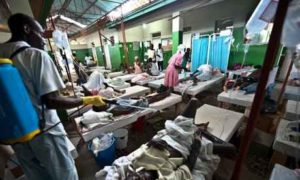
Robert Muggah-guardian.co.uk,
A year on from the earthquake, more than a million are still living in tents and less than a tenth of aid cash has been delivered.
Despite breathless promises to “build back better”, the international community has made only incremental progress in Haiti over the past 12 months. Our failures are especially stark when measured against the genuine displays of global solidarity with Haiti in the wake of the the January earthquake and financial pledges to reconstruction three months later, in March.
Even if some allowance is made for the extraordinary devastation wrought by the disasters, few disagree that the Haitian government’s handling of the situation has been spectacularly poor. Likewise, with few exceptions, the international aid sector’s record has been dismal. Notwithstanding efforts to signal political commitment to supporting Haiti’s transition – including UN secretary general Ban Ki Moon’s appointment of Bill Clinton as special envoy – few tangible outcomes have yet to be materialise. Haitians themselves are growing disillusioned and impatient, and signs of violence are apparent in the streets of wrecked Port-au-Prince.
And while 2010 was grim, there are few guarantees that 2011 will be any better.
Veteran disaster relief and development workers acknowledge that the process of recovery and reconstruction takes time. But in Haiti, donors have been especially slow in identifying priorities, disbursing funds and supporting (rather than substituting for) local capacity. Although the international community promised almost $10bn in aid earlier in 2010, very little has actually arrived. What is more, support appears to be dwindling. In 2010, more than 35 countries and multilateral agencies pledged roughly $3.8bn to reconstruction. Going into 2011, pledges have diminished to 20 countries amounting to $1.5bn.
The coordination and commitment deficit is hardly new to Haiti. Even before the earthquake, longstanding and newer donors were hoping to taper down their security and development contributions. While the UN Stabilisation Mission in Haiti’s (Minustah) mandate has been repeatedly extended, major troop and police contributing states (such as Brazil), as well as aid providers such as Canada and the United States, were searching for an exit strategy.
In the meantime, the Haitian Interim Recovery Commission – the government mechanism designed to coordinate and prioritise international investment – has failed to lift off. And while the commission approved some $1.6bn in projects in August 2010, it is not clear whether these initiatives can be sustained much beyond 2011.
Taken together, less than a tenth of the total amount promised has even arrived in Haiti, much less been spent.
Also worrying is the way in which development aid agencies are resorting to old practices, including preferential treatment of their own contractors. On the grounds of minimising the risk of wasting aid through corruption, “no bid” contracting is now the norm. This results in serious distortions in aid allocations: out of every $100 pledged by USAID, for example, Haitian firms are awarded less than $2. Other major donors are following suit. This runs counter to the now widely-held view among development professionals that supporting local capacity and ingenuity is key to sustainable successful outcomes.
As most Haiti watchers know all too well, the situation before the earthquake was dire. Despite meagre economic gains in 2009, the country was at the very bottom of virtually every international index. And while this “Republic of NGOs” was visited by massive promises of assistance and an additional 500 relief agencies in 2010, Haiti’s three horsemen of the apocalypse – displacement, disease and instability – have brought the nation to its knees.
Almost 12 months after the earthquake, there are still an estimated 1.3 million people living in tents, waiting to be relocated to new houses. Recent household survey data revealed how, in the months after the quake, these population groups were the most food insecure. Less than a third of them claimed to have had access to international assistance, and most managed to survive owing to resilient social networks, including remittances from Montreal to Miami.
In the meantime, a cholera epidemic has killed over 2,500, infected over 100,000 and could kill thousands more, if not immediately contained. According to epidemiologists, the pathway of the epidemic since October – running as it has from north to the central and southern regions – suggests that it has spread virtually unhindered. Water purification tablets, improved sanitation and small adaptations in personal hygiene could effectively control its movement.
Finally, the country continues to be wracked by political instability. The lack of leadership and poor handling of the elections have been reported on extensively. Most of the 18 presidential candidates – some with links to the former regime of Duvalier dictators (father and son) – proved incapable of providing a compelling vision for Haiti’s masses. The persistent allegations of fraud and intimidation during the electoral cycle were as predictable as they were depressing. The poor way in which the vote count was managed and the weak response of outsiders (notably, with the OAS and Minustah refusing to acknowledge the full extent of “irregularities”) guarantee continued unrest in 2011.
The international community could not stop the earthquake, but surely it can deliver on its promise to help Haitians reconstruct their battered country.